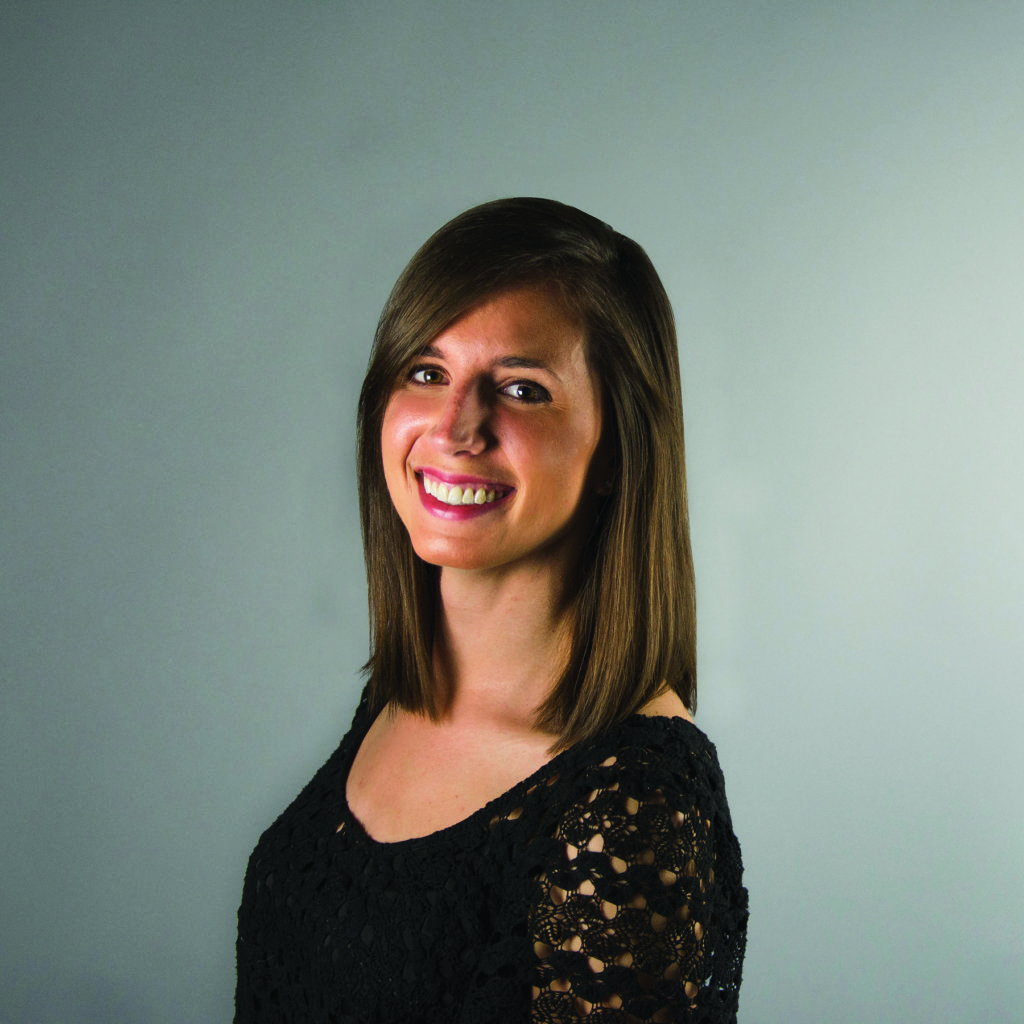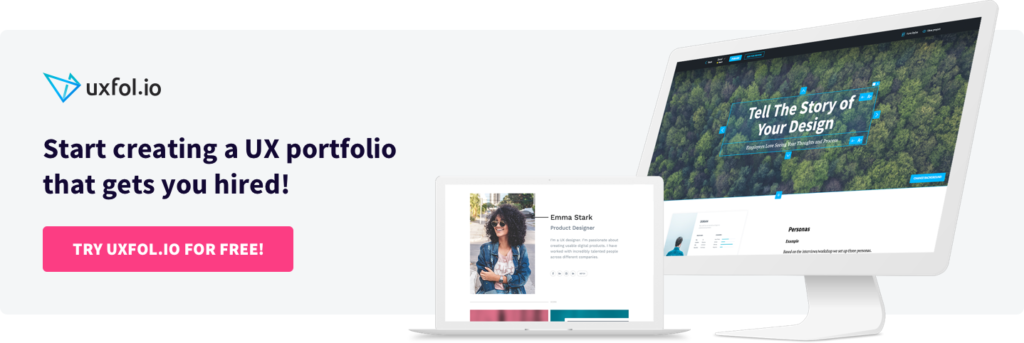Rebecca Henderson is an Associate Interaction Design Director at IA Collaborative. She has a total of 8 years of experience in experience and interaction design, being experienced in quite a lot of specialties and tools: User Experience Design, Information Architecture, Wireframing, Sketching, Motion Design, HTML/CSS/JavaScript, Letterpress, Film & Darkroom.
She also likes studying what interactions the brands have with UX choreography, which field can be found at the intersection of motion and UX.
Rebecca told us about how she became an Associate Director of Interaction Design at IA Collaborative and how is it to work there. She also shared her thoughts on what skills UXers need and how they can showcase these in a UX designer portfolio.

Hi Rebecca! It is a great pleasure to have you on our blog. Could you please tell me a bit about your career path?
I studied communication design at Carnegie Mellon and had assumed I would go into the field as a visual/graphic designer. At the time, I really didn’t understand what UX really was. I was applying to R/GA at the time (it was my dream job while in school!) for their visual design department, but during my interviews, they asked whether I’d be interested in UX because I seemed better fit for that.
I said sure, even though I didn’t fully understand that role — I was just so desperate for a job and to work there! They ended up hiring me and I started day 1 not even knowing what a wireframe was. I learned everything on the job. I really sought out the help of some great mentors during my first few years who got me exposure to many unique projects.
I wanted to dabble in everything to get a full sense of what this role of UX was all about. Over time I was promoted a few times, and by the time I was a senior designer I was really started to evaluate the “unique perspective” I could bring to my field, trying to develop subject-matter expertise — like in motion design.
I was really happy at R/GA and ended up staying 5 years because it felt like I never stopped learning. By the time I left, I was an Experience Design Director and was in a leadership role. I pivoted to IA Collaborative because I wanted to see what else was out there aside from agency life and I wanted to see what a design consultancy would be like. The types of projects IA had were much more interdisciplinary and involved much more design research — which you really don’t do much of at an agency.
Growing more leadership skills was one of my biggest goals since joining and I was eventually made an Associate Director of Interaction Design this year!
Sounds amazing! What are you looking for when you or your company IA Collaborative check a designer candidate’s portfolio?
I want to have a good understanding of the role someone had on a project and how they worked with other people.
“I really like seeing
process work. […] In addition to seeing the final solution, I like seeing an element of self-reflection at the end.”
I really like seeing process work, particularly some ideas the team did not go with and why. In addition to seeing the final solution, I like seeing an element of self-reflection at the end.
I often ask people in interviews, “if you were to do this whole project again, what would you change?” and strong candidates are the ones who always are ready to answer this.
No project is perfect and we learn from every experience, so I like when someone demonstrates this.
What are the most important skills of a designer working on digital products?
Curiosity, the ability to iterate, and clear communication skills.
Great designers are always questioning the norm, looking ahead, and constantly asking themselves “why?”.
They also don’t get married to their ideas, and know how to tell a compelling story with their work.

What do you suggest, how can one showcase these skills in a product design portfolio?
“Demonstrate your role at each step of the process.”
Start with the prompt that was given to your team and demonstrate your role at each step of the process: from research and strategy to prototyping to final design and craft.
Don’t just show the “obvious” solutions to something.
In your opinion how important it is to show the design process and design decisions in a UX portfolio?
Very important.
I’m often imagining what it would be like to work alongside this candidate and how their processes would mesh with our own at IA.
What does your processes at IA look like?
We’re extremely collaborative (it’s in our name). Everyone works in a dedicated project room. You don’t have a dedicated “desk” in the office, you just bounce around to the projects/rooms you’re on.
Everything we do is really analogue. Even if it’s a digital project, we’ll constantly print out progress work and pin it on the walls, having ad hoc critiques throughout the day.
Everyone’s really open and approachable at IA. You’re constantly talking to your team and getting their input on everything you do. We often tell people that it feels like when you enter a project room, you kind of “leave your title at the door.”
What I mean by that is that even though your team may be comprised of a researcher, UX designer, graphic designer, and account lead, everyone’s role feels blended and you’re expected to “wear many hats.”
You’ll be involved in every step of the project, even if it’s not your discipline’s main role.
How should UXers tell their design story or process in a portfolio? What format or structure would you recommend to use?
A clear outline of the process helps build a strong narrative. It helps to be thorough, but you don’t have to make it too dense with copy (you can always add more color during an interview)! Lots of process photos also help me get a sense of how someone works and thinks.
“A clear outline of the process helps build a strong narrative. […] Process photos also help me get a sense of how someone works and thinks.”
I don’t have a strict format to recommend beyond that, but I usually begin by scanning through a project and then pausing on a few aspects to get details.
I will then rely on a phone call or in person interview to see how well a candidate can talk through the story of their work too.
What are the mistakes you see in many design portfolios?
Too many projects that don’t give a clear picture of what this candidate both wants to be doing next and where they’ve come from.
Jumping to final solutions on a project.
Not giving enough credit to the rest of the team who may have worked on it.
What kind of design-related positions do you have in your organisation and what are these people doing in a daily basis?
Research & Design Strategy, Interaction Design, Creative Technology, Graphic Design, Industrial Design, Architectural Experience Design, Engineering.
We have an extremely wide range of work: digital, CPG, branding, spatial experiences, physical product design, design “labs” and more.
Every team is interdisciplinary and works together in a dedicated project room. You’ll be on a project for the entire duration (i.e. just because the research phase is over, it doesn’t mean you’ll roll off the project) and it’s expected that you’ll “wear many hats”, as I already mentioned. For example, our designers are extremely involved in research protocol creation.
What is the selection process in your company?
Hiring depends on future project needs. If any discipline has an opening, we first screen potential candidates via phone and then bring them in for a series of interviews (where members of all disciplines attend).
Each interview is focused on different criteria, such as a portfolio review and one focused on leadership and collaboration.
What advice would you give to a junior designer?
Sometimes junior designers get self conscious about the work they have available in their portfolio.
If you feel like your portfolio isn’t that exciting (let’s say your first job had you doing something like banner ads all day) and it doesn’t reflect what you want to be doing next, take on a personal project or two to get more material.
“Take on a personal project or two to get more material. […] Personal projects will not only help you practice new skills, but I often admire designers who have that initiative and motivation in them.”
Don’t let that one job totally define you and always position your portfolio in a way that represents your ideal role.
Personal projects will not only help you practice new skills, but I often admire designers who have that initiative and motivation in them.
Yes, exactly. We, at UXfolio, also recommend junior designers to do side projects, UX design internships or pro bono work and present these in their portfolios.
Thank you very much, Rebecca, for all of the useful advice. I’m sure this interview will help many UX professionals build more meaningful portfolios.

In case you want to create a meaningful UX portfolio, UXfolio a great platform for it.
We created this tool to support UX professionals with portfolio building. It is easy and quick to build a portfolio that contains all the details Rebecca talked about. It generates your portfolio website, a stunning cover page, and it helps you put together nice project case studies in minutes.
It gives you help in the copywriting part with great examples and guiding questions. And you can even ask for detailed reviews on your case studies before applying for your next job.
Start building your meaningful UX portfolio: Click here to sign up to UXfolio and try it out!